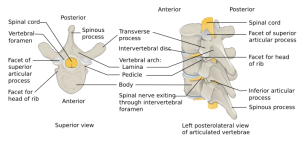Thoracic and lumbar fractures and dislocations
(Redirected from Thoracic and lumbar spine trauma)
Background
- Injury to thoracic spine necessitates severe force
- thoracic spine has enhanced stiffness secondary to articulations with the rib cage
- When spinal cord injury occurs usually complete
- thoracic spinal canal is narrower than in other regions, increased risk of cord injury
- Important to evaluate for thoracic spine injuries and aortic injuries in the setting of blunt chest trauma with mediastinlal widening
- Follows the three column model - Stable if two or more of the spinal columns are intact:
- Anterior (anterior longitudinal ligament, annulus fibrosus, ant. half of the vertebral body)
- Middle (posterior longitudinal ligament, posterior annulus fibrous, and post. half of vertebral body
- Posterior (supraspinous and interspinous ligaments, ligamentum flavum, facet joint capsule)
- Unstable if:
- 50% loss of vertebral height
- Kyphotic angulation around the fracture:
- >30' for compression fracture
- >25' for burst fracture
- Neurologic deficit
Vertebral fractures and dislocations types
- Cervical fractures and dislocations
- Thoracic and lumbar fractures and dislocations
Clinical Features
- Typically pain over site of injury
Differential Diagnosis
Thoracic Trauma
- Airway/Pulmonary
- Cardiac/Vascular
- Musculoskeletal
- Other
Lower Back Pain
- Spine related
- Acute ligamentous injury
- Acute muscle strain
- Disk herniation (Sciatica)
- Degenerative joint disease
- Spondylolithesis
- Epidural compression syndromes
- Thoracic and lumbar fractures and dislocations
- Cancer metastasis
- Spinal stenosis
- Transverse myelitis
- Vertebral osteomyelitis
- Ankylosing spondylitis
- Spondylolisthesis
- Discitis
- Spinal Infarct
- Renal disease
- Intra-abdominal
- Abdominal aortic aneurysm
- Ulcer perforation
- Retrocecal appendicitis
- Large bowel obstruction
- Pancreatitis
- Pelvic disease
- Other
Evaluation

Thoracic compression fracture of T12.
Workup
- Type and screen/cross, labs including pancreatic enzymes if thoraco-lumbar location
- Indications to Image Thoracic and Lumbar Spine after Trauma
- Mechanism
- Gunshot, High energy trauma, Motor vehicle crash with rollover or ejection, Fall >10 ft or 3 m, Pedestrian hit by car
- Physical Exam
- Midline back pain, Midline focal tenderness, Evidence of spinal cord or nerve root deficit
- Associated injuries
- Cervical fracture, ribe fracture, aortic injuries, hollow viscus injuries
- Mechanism
- Plain radiographs or CT scan to evaluate for body abnormality
- Can reformat Chest and Abdomen CT to look at thoracic, lumbar spine
- MRI is diagnostic test of choice to evaluate patients with nerve injury
- CT myelography alternative when MRI unavailable
- anterior vertebral body compression fracture with extension through middle of vertebral body into posterior wall
- Compression fracture + increased posterior interspinous spaces caused by distraction
10% of patients with a spine fracture have second fracture in a different segment
CT IF:
- Compression
- Wedge
- >50% height (rule out middle column & burst)
Diagnosis
Management
- Spinal precautions
- Consult ortho or neurosurgery (institution dependent)
- Stable fractures
- TLSO brace in discussion with consulting service
- Unstable fractures
- Emergency operative repair unless medically unstable




